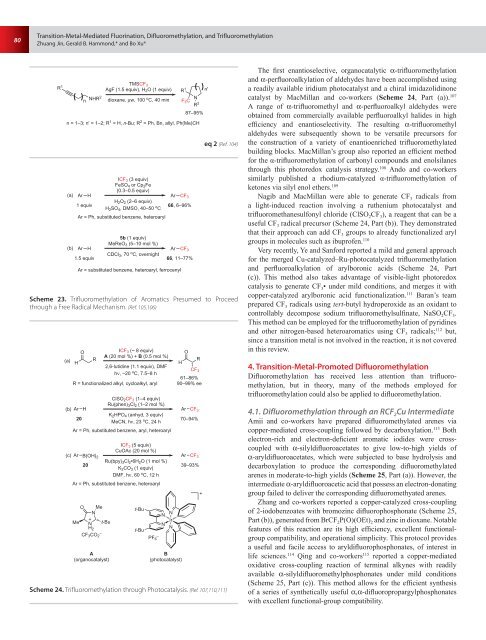Aldrichimica Acta Vol. 45, No. 3 - Sigma-Aldrich
Aldrichimica Acta Vol. 45, No. 3 - Sigma-Aldrich
Aldrichimica Acta Vol. 45, No. 3 - Sigma-Aldrich
Create successful ePaper yourself
Turn your PDF publications into a flip-book with our unique Google optimized e-Paper software.
80<br />
Transition-Metal-Mediated Fluorination, Difluoromethylation, and Trifluoromethylation<br />
Zhuang Jin, Gerald B. Hammond,* and Bo Xu*<br />
R 1<br />
NHR2 TMSCF3<br />
AgF (1.5 equiv), H2O (1 equiv)<br />
n dioxane, µw, 100 oC, 40 min<br />
R<br />
N<br />
1 n'<br />
F3C<br />
R<br />
87–95%<br />
2<br />
n = 1–3; n' = 1–2; R 1 = H, n-Bu; R 2 = Ph, Bn, allyl, Ph(Me)CH<br />
(a) Ar H<br />
(b) Ar H<br />
1.5 equiv<br />
ICF3 (3 equiv)<br />
FeSO4 or Cp2Fe<br />
(0.3–0.5 equiv)<br />
H2O2 (2–6 equiv)<br />
H2SO4, DMSO, 40–50 o 1 equiv<br />
C<br />
Ar = Ph, substituted benzene, heteroaryl<br />
5b (1 equiv)<br />
MeReO3 (5–10 mol %)<br />
CDCl3, 70 o C, overnight<br />
Ar CF3<br />
66, 6–96%<br />
Ar CF3<br />
66, 11–77%<br />
Ar = substituted benzene, heteroaryl, ferrocenyl<br />
eq 2 (Ref. 104)<br />
Scheme 23. Trifluoromethylation of Aromatics Presumed to Proceed<br />
through a Free Radical Mechanism. (Ref. 105,106)<br />
(a)<br />
H<br />
O<br />
R<br />
R = functionalized alkyl, cycloalkyl, aryl<br />
(b) Ar H<br />
ClSO2CF3 (1–4 equiv)<br />
Ru(phen)3Cl2 (1–2 mol %)<br />
20<br />
K2HPO4 (anhyd, 3 equiv)<br />
MeCN, hν, 23 oC, 24 h<br />
Ar = Ph, substituted benzene, aryl, heteroaryl<br />
ICF3 (5 equiv)<br />
CuOAc (20 mol %)<br />
(c) Ar B(OH)2<br />
20<br />
Ru(bpy)3Cl2 6H2O (1 mol %)<br />
K2CO3 (1 equiv)<br />
DMF, hν, 60 oC, 12 h<br />
Ar = Ph, substituted benzene, heteroaryl<br />
O Me<br />
Me<br />
N<br />
+<br />
N<br />
H2<br />
t-Bu<br />
CF3CO2 –<br />
A<br />
(organocatalyst)<br />
ICF3 (~ 8 equiv)<br />
A (20 mol %) + B (0.5 mol %)<br />
2,6-lutidine (1.1 equiv), DMF<br />
hν, –20 o C, 7.5–8 h<br />
t-Bu<br />
t-Bu<br />
PF6 –<br />
N<br />
N<br />
N<br />
Ir<br />
N<br />
B<br />
(photocatalyst)<br />
O<br />
R<br />
H<br />
CF3<br />
61–86%<br />
90–99% ee<br />
Ar CF3<br />
70–94%<br />
Ar CF3<br />
39–93%<br />
Scheme 24. Trifluoromethylation through Photocatalysis. (Ref. 107,110,111)<br />
+<br />
The first enantioselective, organocatalytic a-trifluoromethylation<br />
and a-perfluoroalkylation of aldehydes have been accomplished using<br />
a readily available iridium photocatalyst and a chiral imidazolidinone<br />
catalyst by MacMillan and co-workers (Scheme 24, Part (a)). 107<br />
A range of a-trifluoromethyl and a-perfluoroalkyl aldehydes were<br />
obtained from commercially available perfluoroalkyl halides in high<br />
efficiency and enantioselectivity. The resulting a-trifluoromethyl<br />
aldehydes were subsequently shown to be versatile precursors for<br />
the construction of a variety of enantioenriched trifluoromethylated<br />
building blocks. MacMillan’s group also reported an efficient method<br />
for the α-trifluoromethylation of carbonyl compounds and enolsilanes<br />
through this photoredox catalysis strategy. 108 Ando and co-workers<br />
similarly published a rhodium-catalyzed α-trifluoromethylation of<br />
ketones via silyl enol ethers. 109<br />
Nagib and MacMillan were able to generate CF 3 radicals from<br />
a light-induced reaction involving a ruthenium photocatalyst and<br />
trifluoromethanesulfonyl chloride (ClSO 2CF 3), a reagent that can be a<br />
useful CF 3 radical precursor (Scheme 24, Part (b)). They demonstrated<br />
that their approach can add CF 3 groups to already functionalized aryl<br />
groups in molecules such as ibuprofen. 110<br />
Very recently, Ye and Sanford reported a mild and general approach<br />
for the merged Cu-catalyzed–Ru-photocatalyzed trifluoromethylation<br />
and perfluoroalkylation of arylboronic acids (Scheme 24, Part<br />
(c)). This method also takes advantage of visible-light photoredox<br />
catalysis to generate CF 3• under mild conditions, and merges it with<br />
copper-catalyzed arylboronic acid functionalization. 111 Baran’s team<br />
prepared CF 3 radicals using tert-butyl hydroperoxide as an oxidant to<br />
controllably decompose sodium trifluoromethylsulfinate, NaSO 2CF 3.<br />
This method can be employed for the trifluoromethylation of pyridines<br />
and other nitrogen-based heteroaromatics using CF 3 radicals; 112 but,<br />
since a transition metal is not involved in the reaction, it is not covered<br />
in this review.<br />
4. Transition-Metal-Promoted Difluoromethylation<br />
Difluoromethylation has received less attention than trifluoromethylation,<br />
but in theory, many of the methods employed for<br />
trifluoromethylation could also be applied to difluoromethylation.<br />
4.1. Difluoromethylation through an RCF 2Cu Intermediate<br />
Amii and co-workers have prepared difluoromethylated arenes via<br />
copper-mediated cross-coupling followed by decarboxylation. 113 Both<br />
electron-rich and electron-deficient aromatic iodides were crosscoupled<br />
with a-silyldifluoroacetates to give low-to-high yields of<br />
a-aryldifluoroacetates, which were subjected to base hydrolysis and<br />
decarboxylation to produce the corresponding difluoromethylated<br />
arenes in moderate-to-high yields (Scheme 25, Part (a)). However, the<br />
intermediate a-aryldifluoroacetic acid that possess an electron-donating<br />
group failed to deliver the corresponding difluoromethyated arenes.<br />
Zhang and co-workers reported a copper-catalyzed cross-coupling<br />
of 2-iodobenzoates with bromozinc difluorophosphonate (Scheme 25,<br />
Part (b)), generated from BrCF 2P(O)(OEt) 2 and zinc in dioxane. <strong>No</strong>table<br />
features of this reaction are its high efficiency, excellent functionalgroup<br />
compatibility, and operational simplicity. This protocol provides<br />
a useful and facile access to aryldifluorophosphonates, of interest in<br />
life sciences. 114 Qing and co-workers 115 reported a copper-mediated<br />
oxidative cross-coupling reaction of terminal alkynes with readily<br />
available a-silyldifluoromethylphosphonates under mild conditions<br />
(Scheme 25, Part (c)). This method allows for the efficient synthesis<br />
of a series of synthetically useful a,a-difluoropropargylphosphonates<br />
with excellent functional-group compatibility.

















